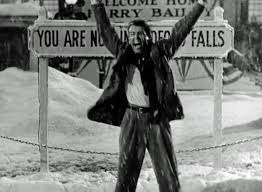There is a scene in the 1954 classic movie On the Waterfront that, one can argue, introduced the world to the art of modern, naturalistic acting. Terry Malloy (played by Marlon Brando) is talking with Edie Doyle (Eva Marie Saint) in a park in the city. He clearly enjoys her company–they only recently met. But she isn’t sure about him, especially because they met in part due to the death of her brother. Not exactly an auspicious way to start a relationship.
And Edie, at this point in the film, has no intention of starting a relationship with Terry. But as they walk together, he talks a mile a minute, engaging her, trying to break the ice. At one point, fiddling with a fashionable pair of white gloves, Edie drops one on the ground. Terry quickly picks it up . . . but doesn’t give it back to her. Instead, he caresses it, explores it, and then puts it on his own hand, all the while continuing with the conversation. Edie doesn’t acknowledge it, though she shows through her glances and body language that she is very aware he now wears her glove.
Terry continues to fiddle with the glove as they talk, even as it’s wrapped around his hand. The message is clear–Edie is not prepared yet to hold his hand. But Terry simulates that action by wearing her glove. It is a subtle, romantic gesture. Eventually, Edie says she has to go, and she reaches for the glove and pulls it off his hand, reclaiming it. They go on talking, as if nothing has happened. It is a remarkably natural scene.
But what makes it more remarkable is . . . none of it was scripted! Sure, the dialogue was. But not the glove. The actress, Eva Marie Saint, did not drop one of her gloves on purpose. It was an accident. Undoubtedly, she thought the director, Elia Kazan, would yell, “Cut!” And they would need to reshoot the scene.
But Brando reacted with lightning-quickness. Without missing a beat, he, completely on his own, picked up the glove and proceeded to do everything just described above. Nowhere in the script did it say, “Edie drops her glove, and Terry places it on his own hand to simulate holding her hand.” That was 100 percent Brando ad-libbing in the moment, so invested in his role that he simply responded naturally and had the instincts to understand his character, his motivations, and the dynamics of the scene.
Eva Marie Saint responded with aplomb as well. She had no idea Brando was going to do that–neither did he, until it happened! But she played off of him, without a script, perfectly. And then when she reached to retrieve her glove from him–all in one fluid motion, without mentioning it–just 100 percent natural–that, too, was obviously unscripted. Just pure instinct.
For his part, screenwriter Budd Schulberg wrote a first-rate script. But he can’t take credit for this scene. It was all the actors ad-libbing and playing off each other.
Of course, even beyond a scene like this one, where the actors, literally, create something out of thin air, a screenwriter is dependent on the cast delivering their lines well. A movie script is words on a page. It is designed to come alive on the silver screen (or on your TV, or on your smartphone). It requires the actors to do their part. The best script can fall flat in the hands of untalented actors. And a so-so script can resonate and move an audience to tears if the performers on-screen bring it to life and make the words sing.
Either way, a screenwriter is dependent. Their words are not enough. In the hands of a Marlon Brando or an Eva Marie Saint, a scriptwriter can appear to be a genius. And Schulberg deserves plenty of credit for his script. But let’s not kid ourselves. On the Waterfront is one of America’s all-time great movies because of the actors.
************************************
For a novelist (or short story writer, or any writer who relies exclusively on the written word), there are no Brandos or Saints to weave their alchemy and turn the words on the page to gold. If you intend for a character’s dialogue to be funny, the words need to convey the humor on their own. There are no gifted actors to deliver the lines and make them their own. It is all on you–the author.
Creating mood, character, subtleties, innuendoes; depicting sarcasm, tone of voice, disbelief. These are things an author needs to do through the crafting of a scene on the page, through the dialogue itself, the setting, the narrative, and a few well-placed and strategic descriptions–as much by showing as possible, keeping the telling firmly in check.
It is an enormous challenge. If you don’t come right out and tell a reader, “Character X is sad” (and you shouldn’t), you have to show the reader–and, again, you need to do it exclusively through your words. There are no shortcuts, no actors to bail you out. No director whose unique camera angles and visual storytelling technique lift your words to the stratosphere. It is all, and only, your words.
That is both the blessing and the curse of writing for the written page. You have 100 percent ownership of the material and the characters. It is your creation; no one else’s.
And, when you think about it . . . that’s pretty exciting. Much more a blessing than a curse. The opportunities are as endless as your imagination.
Thanks so much for reading!
–Mike
Terry Malloy
Edie Doyle






































































































